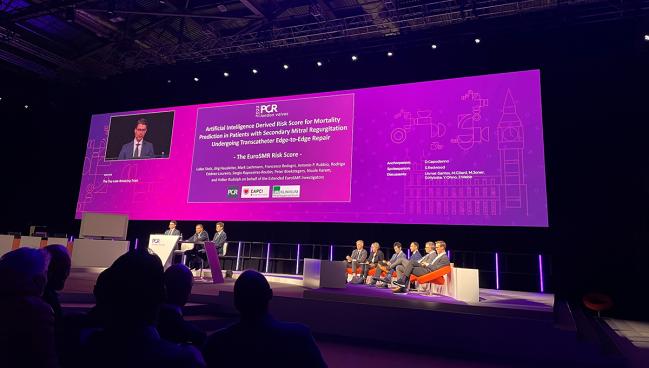EuroSMR Score Outperforms Other Tools for M-TEER Risk Profiling
The risk calculator, developed using artificial intelligence, may help in patient and heart team discussions, its developers say.

LONDON, England—A risk score developed using artificial intelligence (AI) can more accurately predict a successful transcatheter edge-to-edge repair (TEER) in patients undergoing the procedure for secondary mitral regurgitation (SMR), outperforming other risk-stratification tools in the mitral space, investigators say.
“We've learned from the COAPT trial and from the MITRA-FR trial that patient selection and risk stratification prior to mitral TEER is key in order to optimize outcomes after the procedure,” said Lukas Stolz, MD (Ludwig-Maximilians-Universität München, Germany), who presented the data last week during the Top Late-Breaking Trials session at PCR London Valves. “Even though there are a couple of risk scores existing at the moment, those are mostly subject to important limitations.”
Previously developed scores, he continued, have been derived from small patient cohorts or extrapolated from the surgical experience and typically do not differentiate between different MR types. Many have lacked independent validation in different study cohorts, he added.
To overcome those limitations, investigators turned to the large European Registry of Transcatheter Repair for Secondary Mitral Regurgitation (EuroSMR) with data on more than 4,600 patients who had undergone mitral TEER, dividing them into derivation (4,172 patients) and validation cohorts (428 patients). Fully 28 different clinical, echocardiographic, laboratory, and medication parameters were fed into the model; the AI-based algorithm then identified 18 factors with the strongest contribution for predicting mortality.
Most strongly correlated with mortality, said Stolz, was NT-proBNP. This was followed by NYHA class, hemoglobin level, tricuspid annular plane systolic excursion (TAPSE), and age in descending order of importance. Some of the items on the list are “typical predictors,” such as ventricular dysfunction and symptomatic status, said Stolz, as well as comorbidities like diabetes and renal dysfunction. But other factors also proved “important,” including use of guideline-directed medical therapy.
An online calculator was created to facilitate per-patient use and calculated SMR scores for all patients in the derivation and validation cohorts. Investigators then used sensitivity analyses to identify a cutoff for 1-year mortality in both groups. In Kaplan-Meier estimates, Stolz showed, the EuroSMR score accurately differentiated between patients who lived or died following TEER, with superimposed curves seen for the derivation and validation cohorts.
Investigators then compared the predictive performance of the EuroSMR score to the previously described EuroSCORE II, the MitraScore, and the COAPT score, showing that the EuroSMR outperformed all three preexisting tools.
Most EuroSMR scores fall between 20 and 80, said Stolz. In additional analyses, no patients found to have a score of 70.9 or higher were alive after 18 months, a threshold that might be useful for identifying the extreme high-risk minority for whom M-TEER would be futile. That said, only 11 patients in the validation cohort—approximately 4%—fell into this extreme-risk group.
“The AI-derived EuroSMR risk score is a novel and improved risk calculator, not only for prediction of 1-year mortality, but also for prediction of 1-year mortality free from severe heart failure symptoms,” Stolz summarized. “The EuroSMR score might not only facilitate talking to your patient and finding the right therapy, but it will possibly also be an important aid for the heart team.”
Study investigators have put their AI-derived EuroSMR calculator online to facilitate uptake.
Research and Practicalities
Following Stolz’s presentation, moderator Davide Capodanno, MD, PhD (University of Catania, Italy), agreed that translating surgical scores, like EuroSCORE II, into the transcatheter domain is “very difficult . . . so having scores that are specifically derived and validated in this setting is important.”
Panelist Yohei Ohno, MD, PhD (Tokai University School of Medicine, Japan), asked whether EuroSMR performed differently in patients with atrial and ventricular MR etiologies, adding, “we know that these two populations are quite different entitles.”
In response, Stolz said that the group has done subanalyses, which they will include in the published manuscript, that confirm the score performs equally well in both MR etiologies.
Other panelists zeroed in on AI’s contribution to this score over and above the kind of multivariate analyses typically performed.
“When we talk about machine learning, it’s like magic, but if you want to take a rabbit out the hat, you need to put the rabbit in first,” observed Ignacio J. Amat-Santos, MD, PhD (Hospital Clínico Universitario, Valladolid, Spain). “I think when we use 28 variables to create a score, we are not doing something very different as compared to multivariate analysis, and probably what we should do to improve even more this score is to [feed] more and more data into this analysis. I think this could even improve the selection of futility.”
At the end of the day, it’s the clinical utility that raises more questions: when we identify patients who are more likely to die within 1 year, what do we do with the information, especially considering it is not 100% sure? Davide Capodanno
Asked for his take on the utility of the score, Capodanno told TCTMD that “with 18 parameters, including echocardiographic, laboratory and medication parameters, this score might be [more] predictive [than other tools] but probably not so user-friendly.” In particular, he said, the need for blood tests like NT-proBNP and hemoglobin, as well as echocardiographic data like TAPSE, might not be readily at hand. “I’m also a bit underwhelmed by the discrimination in the derivation cohort at the end of machine learning: 0.768 is fair, but not exceptional,” he commented. “Sensitivity and specify of detecting nonsurvivors were also quite low with the best proposed cutoff.”
What struck him the most from the presentation was just how difficult it is to model prediction in SMR and how poorly the existing scores are performing, Capodanno said. “But, at the end of the day, it’s the clinical utility that raises more questions: when we identify patients who are more likely to die within 1 year, what do we do with the information, especially considering it is not 100% sure?”
Speaking with TCTMD, Stolz stressed that other risk scores are used in everyday practice and it’s important to understand that EuroSCORE II, perhaps the most commonly used tool, was validated in a surgical cohort and has “basically nothing to do with what we are doing on the transcatheter side.”
As to Capodanno’s point that some of the factors required for the calculations may not be easily at hand, Stolz clarified that the calculator still works without needing to be imputed with every single component. “That is one of the advantages, you can leave out what you don’t have and you will nevertheless get a score,” he said.
Next steps, Stolz said, will be to test the score in other validation cohorts, including non-European patients. For now, “this a great tool to talk to a patient in order to give them an idea of what their risk for the procedure is or not,” he said. “The other thing is, we tried to identify a small subset of patients that is so sick that they won’t even [survive] one or one and a half years after the procedure. If you look at cancer therapy, for example, it’s common to switch to a palliative approach” if a therapy has a low chance of success. Based on this study, only a small percentage of patients would derive no benefit from TEER, Stolz noted, “but it’s important to identify that small subset of patients that shouldn’t have it.
Shelley Wood was the Editor-in-Chief of TCTMD and the Editorial Director at the Cardiovascular Research Foundation (CRF) from October 2015…
Read Full BioSources
Stolz L. Artificial intelligence derived risk score for mortality prediction in patients with secondary mitral regurgitation undergoing transcatheter edge-to-edge repair. the EuroSMR risk score. Presented at: PCR London Valves. November 19, 2023. London, England.
Disclosures
- Stolz reports receiving speakers fees from Edwards Lifesciences.





Comments